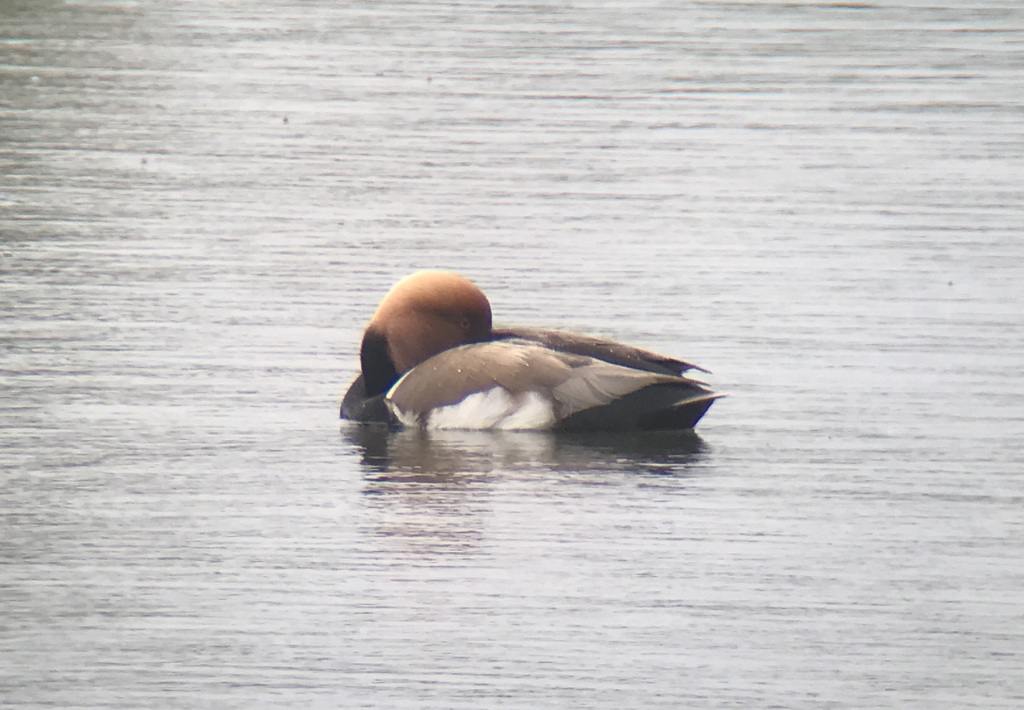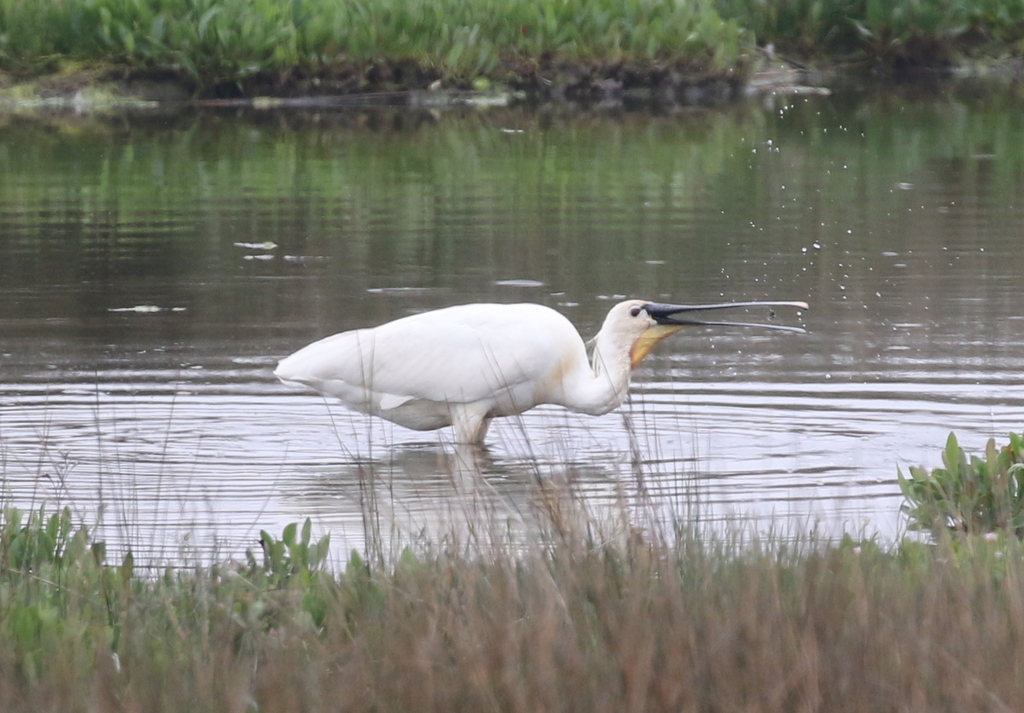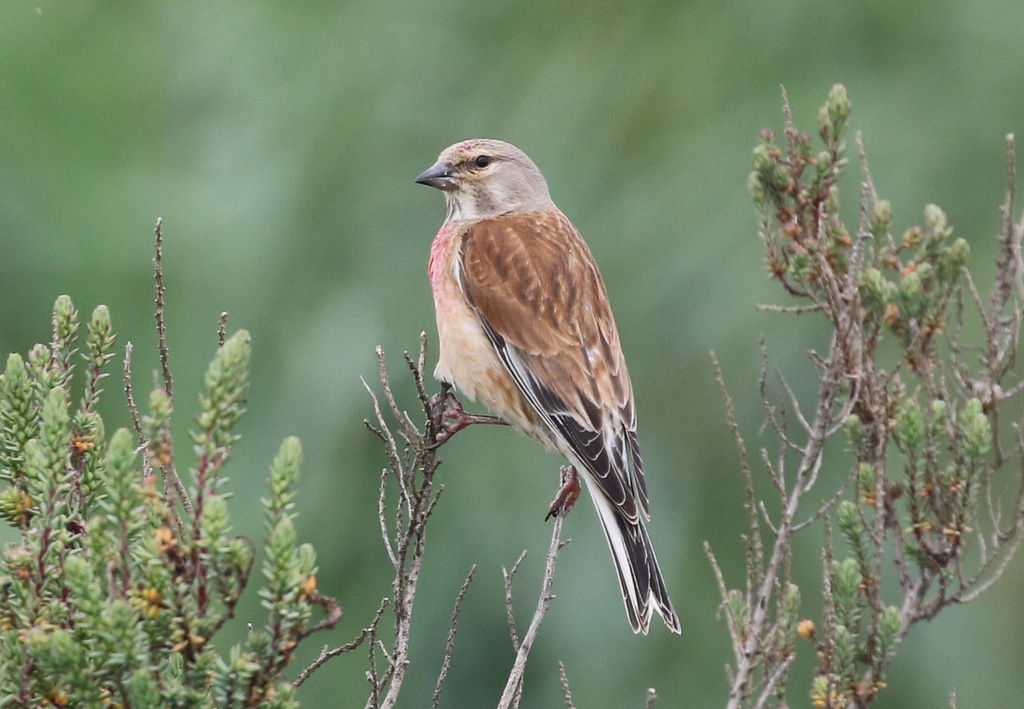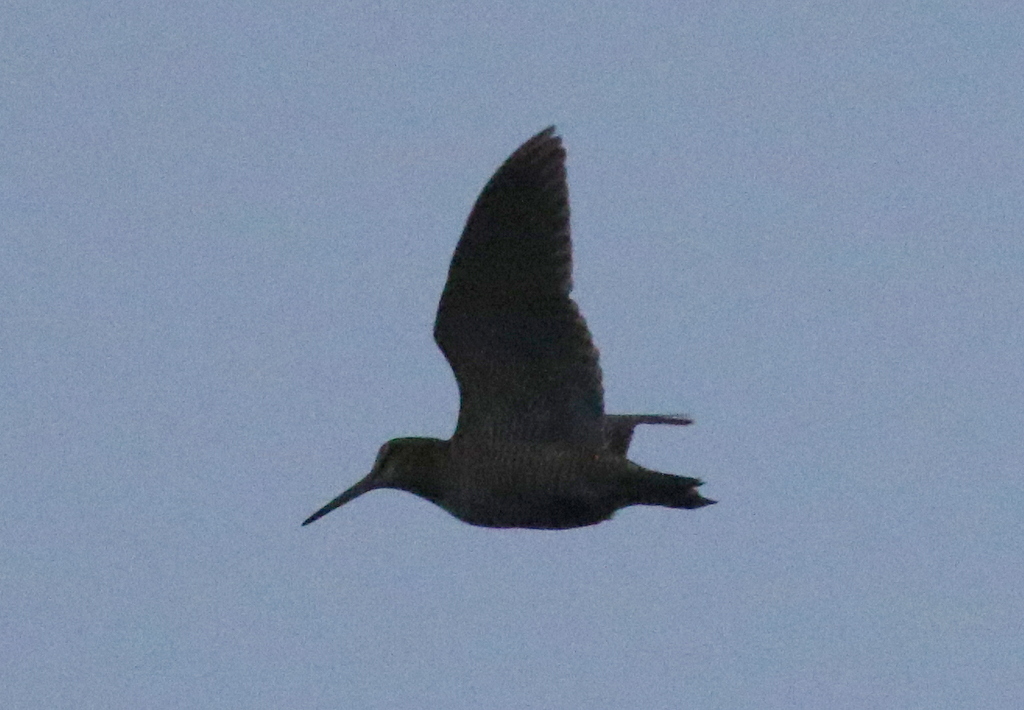Day 2 of a three day long weekend of Early Summer Tours today. It was misty or cloudy pretty much all day, although it lifted a bit at times. However, it was thankfully mostly dry – with just a brief period when it was spitting with rain in the morning.
We headed over to Titchwell first, with the option of the hides if we did need to shelter from the weather. The car park was quiet when we arrived, so we had a look around before it got busy. There were Blackcaps and Long-tailed Tits in the trees where we parked, and a pair of Song Thrushes collecting food in the overflow car park. Looking out from the gate at the back, a Red-legged Partridge was feeding on the track beyond and a Marsh Harrier was perched in one of the dead trees out in the reedbed beyond. A Spoonbill flew off high to the east, away from us.
Out onto the reserve, we made our way round on Fen Trail out to Patsy’s Reedbed first. A Blackcap showed well in the trees right above the path and we got a quick look at both Sedge Warbler and Reed Warbler in the reeds in front of Fen Hide as we passed.
Patsy’s Reedbed held a few duck, notable among them a single drake Red-crested Pochard. There were five Teal on here too today – almost all of the birds which spent the winter here have long since departed, but a small number typically oversummer here. A couple of Marsh Harriers circled over the reedbed beyond.

It started to spit with rain now, so we started to make our way over towards the main path. A Chiffchaff was singing above the boardwalk as we passed. The rain had pretty much stopped by the time we got round there, so we stopped to see what we could find in the reeds.
A Jay flew across above the reeds and landed in one of the sallows. As it did so, what sounded like a Tawny Owl called quietly. We had a look in the bush, but there was no sign of one that we could see from the bank. There were lots of Reed Warblers zipping back and forth across the pools on the near edge of the reeds.

The reedbed pool held a single Great Crested Grebe, as well as two more Red-crested Pochard. Two or three Bearded Tits flew back and forth over the water and a Little Grebe laughed at us from the channel just beyond. There was a large melee of gulls and Jackdaws circling over the reeds at the edge of freshmarsh, presumably hawking for insects.
As we opened the windows in Island Hide, we noticed a good numbers of godwits out on the nearest island. On closer inspection, we could see a mixture of both Bar-tailed Godwits and Black-tailed Godwits together. Something spooked them and they flew before everyone could get a look at them through the scope, but thankfully after circling for a minute or so they settled again, this time largely separating themselves into two separate flocks.
There were not many other waders on here today, apart from the ubiquitous Avocets. There seem to be fewer of them this year here too, although there appears to be no shortage elsewhere along the coast. Perhaps the colony of gulls, which is dominating the freshmarsh this year, has put them off? Two Little Terns were resting on one of the islands and through the scope we could see their black-tipped yellow bills and white foreheads.
As we set off along the main path again, we scanned back over the reeds. The gulls had all spread out now and we could see two immature Little Gulls hawking back and forth among all the Black-headed Gulls.
The mist started to roll in again, so we headed straight round to Parrinder Hide. When we got there, one of the Little Gulls had landed on the edge of one of the islands in front of the hide, so we got a much better look at that now. A 1st summer, we could see the extensive black feathering in the wings, the dark spot behind the eye and a pale pink suffusion on its underparts.

An adult Mediterranean Gull dropped in on one of the other islands, where a number of Black-headed Gulls and 1st summer Common Gulls had gathered to loaf and preen. Through the scope, we noted the jet black hood with contrasting white eyelids, bright red bill and legs, and the pure white wing tips. There were also a couple of Lesser Black-backed Gulls with the Herring Gulls standing in the water further back.
There were better views of the godwits to be had from here, including a smart Bar-tailed Godwit in full breeding plumage, with rusty underparts extending right down under the tail. Four Avocets were busy feeding in front of the hide, sweeping their bills from side to side in the shallow water. When the Avocets started to alarm call, we looked up to see a Hobby flashing low across in front of the hide, disappearing off towards Island Hide.
The mist lifted again, so we made a quick dash out to the beach. There was very little on Volunteer Marsh today, but as we got over the bank at the far end, we noticed a large white bird out on the saltmarsh the other side. It was a Spoonbill, busy feeding, walking around with its head down in the water. It seemed to be catching a lot, as every few steps it seemed to flick its head up, at which point we could see its distinctive bill, with the yellow tip indicating it was an adult.

While we were watching the Spoonbill, a smart male Linnet landed in the bushes just below us. A little further on, two male Reed Buntings were singing against each other, with one perched nicely just out from the path.

The Tidal Pools are not tidal any more and largely full of deep water, so there are very few birds on here these days. A group of twenty or so Oystercatchers were sleeping on the saltmarsh towards the back. That was because, out at the beach the tide was just going out and was still covering the mussel beds. Consequently, there were not many waders out here yet, just a few more Oystercatchers on the sand.
It was still rather misty offshore, but it rolled back just enough for us to see a steady procession of terns flying back and forth, mainly Sandwich Terns but also a couple of Common Terns and Little Terns too. Two Fulmars flew past as well, hugging the sea. Then it was time to head back to the visitor centre for lunch.
After lunch, we paid a quick visit to Holme. It was the wrong time of the day now, but we wanted to try our luck to see if we might be able to find a Turtle Dove here. As we walked round via the paddocks, it was rather quiet. A Common Whitethroat called from the brambles and a Greenfinch was singing out in the bushes. We could hear a Cuckoo singing too, off in the distance.
As we got to the far end of the paddocks, we heard some hissing calls coming from a large hawthorn bush. A Tawny Owl hooted from the trees further back, appearing to answer the hissing calls. We had a look in the bushes but we couldn’t see anything.
Continuing on down towards Beach Road, a Cuckoo flew across as we got out of the trees into grassy the car park. Another Cuckoo was still singing in the distance ahead of us, so there were two of them here today. We walked over to see if we could find the second bird, but it seemed to move further away, off towards the coast road the next time we heard it.
Walking back along the Holme Dunes entrance track, a Swallow landed on the wires just above us. While we were watching it, two Cuckoos flew in and dropped down into the trees at the back of the paddocks. As they landed, the male gave its traditional ‘cuckoo’ song, and the female answered with a bubbling call.

Then a second male Cuckoo flew in and landed on a dead branch in the top of a tree behind us. The two males started singing off against each other, getting very over-excited. There were lots of extra ‘cucks’ given to each ‘oo’! Then the female flew off towards Redwell Marsh and the males drifted away too. As we walked back to the car, a Cetti’s Warbler shouted to us from one of the ditches.
We drove back east to Holkham to finish the day, walking west on the inland side of the pines. It was fairly quiet here now, apart from lots of people out walking their dogs! We could hear one or two Blackcaps and Chiffchaff singing in the trees. A Treecreeper was singing too, but deep in the pines. A Goldcrest was slightly more accommodating – we could see it flitting round in an oak tree briefly. A large family party of Long-tailed Tits, with several recently fledged juveniles flew across the path.
At Joe Jordan Hide, we had only just opened the flaps when a Great White Egret flew in round the back of the trees. It landed out of view at first, behind some reeds, but then flew again and landed in a shallow ditch. We could see it as it walked along, its head, neck and shoulders sticking up into view. We could see its bill was mostly dark but with a yellow base. A little while later, another Great White Egret flew out of the trees and off east. We could tell it was a different bird as it had an all dark bill.

There were Spoonbills coming and going from the trees too, flying in and out either side. One perched up nicely where we could get a good look at it through the scope, noting its shaggy nuchal crest, a sign of an adult in breeding plumage. There were a few Little Egrets flying back and forth to and from the trees too, and lots of Cormorants visible in their nests in the branches.
Then it was time to head back – we had a busy evening ahead. As we drove back up Lady Anne’s Drive towards the road, a Grey Partridge was feeding in the edge of one of the fields, just beyond the fence.

Nightjar Evening
After a couple of hours to rest and get something to eat, we met again early in the evening. It had been raining all day further east, but fortuitously had stopped in time for our evening activities.
There were several Brown Hares we had to avoid in the road, on our way up to look for Little Owls first. We stopped by some farm buildings and scanned the roofs to see if we could find one out already, but all we could see at first was a Stock Dove. However, when we looked over at some other buildings the other side of the road, there was a Little Owl perched out in the open on the metal framework on a silo.
It was distant from here, but we had a look at the Little Owl through scope. We could see the ‘false face’ on the back of its head, which made it look like it was looking back at us. We made our way over to those building and got much closer, better views. This time it looked round at us properly.

Having enjoyed good views of Little Owl, we drove round to try to find a Barn Owl next. There was no sign of any around a series of favoured hunting meadows we tried at first, so we stopped and got out for walk. We hadn’t gone far when one of the group spotted a Barn Owl flying past behind us. It was carrying prey and we watched as it crossed the road back where we had parked and continued on over the fields beyond, presumably taking the food back to a brood of hungry owlets somewhere.
It was time to head up to the heath now, in time for the evening’s main event. As we walked out to middle the middle, we could hear a Garden Warbler singing from a clump of birch trees.
The first Woodcock appeared pretty much bank on time. We heard its squeaky call first, and then spotted a dark, pot-bellied shape flying towards us with strange stiff, rapid wingbeats. It was a male doing its distinctive ‘roding’ display flight. As it came overhead, we could see its long straight bill.

The Woodcock were regular from then on – we could hear them flying round and several times they passed overhead, at one with two males flying together out across the heath, before they split and headed off in two different direction.
A short while after the first Woodcock, a Nightjar churred briefly from the edge of the trees just ahead of us. Trying to anticipate where it would fly to first, we were just getting into position when it came up out of the trees. It landed briefly on one of its favourite perches, but unfortunately didn’t settle and was off again before we could get the scope onto it.
It flew round, then went high up over the trees, calling. When it came down again, the Nightjar flew in and circled round over our heads. A great view! We could see it was a male, with bold white wing patches. It flew back to the trees, weaving in and out, then off over low over the heath past us. As we walked back to the main path, it came back in behind us and landed on the perch again, but only briefly, before heading off once more.

As we walked on across the heath, we could hear a Tawny Owl hooting in the trees away in the distance. A second male Nightjar started churring out in the middle ahead of us. We made our way over to one of his favourite branches, hoping it might fly in to visit that next. But before we could get there, it flew past and landed on just the perch we were hoping it would visit. We managed to get it in the scope, but before everyone could get a look it was off again.
The Nightjar headed back out into the middle of the heath, and started churring from another tree. It seemed to be responding to a third male which had started up, churring much further over. We stood and listened – stereo churring!
It was great standing out on the heath as the light faded, listening to the Nightjars churring around us, but it was getting dark and time to call it a night. On the walk back, we could hear the Woodcock still roding, and a pair of Nightjar flew past in front of us calling, silhouetted against the last of the light.
There were a few Common Toads out tonight, after the rain earlier. We had to be careful not to tread on them. There was one more surprise in store for us too – a Slow Worm on the edge of the path. It stopped motionless in the torchlight for a couple of minutes, allowing us a great close-up look at it, before it slid off into the bushes by the path. A great way to end the evening.
















